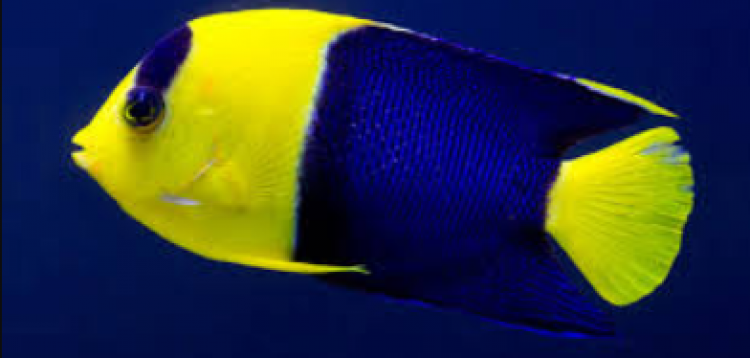- Name:
Queen Angelfish
- Family: Pomacanthidae
- Species: Angel Large
- Scientific Name: Holacanthus ciliaris


General info about Queen Angelfish
The Queen Angelfish is one of the most striking of all angelfish. Vibrant yellow and electric sapphire-blue highlights give the Queen Angelfish an almost iridescent appearance. It has a dark spot on the forehead surrounded by bright blue. The dorsal and pelvic fins are elongated. With the potential of reaching an impressive 18 inches, the Queen Angelfish needs a large tank, with lots of hiding places and live rock for grazing. Not a good reef dweller, the Queen Angelfish is prone to nip at stony and soft corals (sessile invertebrates) and clam mantles. It can be aggressive, so it must be introduced to the community tank last. A somewhat difficult angelfish to keep, Queen Angelfish often suffer from incorrect water parameters and diet. The Small Juvenile will contain the Juvenile colorations or may be color shifting to a young adult, while the Medium will be a sub-adult, and the Large will be in Adult coloration.
Queen Angelfish Diet & Nutrition
Queen angelfish feed primarily on sponges, but may also feed on tunicates, jellyfish and corals as well as plankton and algae. Juvenile Queen angelfishes are also known 'cleaners' feeding on the parasites of larger fishes. In the aquarium it is recommended that they are fed with a diet consisting of Spirulina, seaweed or nori, some meaty fare such as krill, mysis shrimp, or crabs, and prepared food made with sponge material. Live rocks with mature algae may also serve as food supplement for this species in the tank.
Determining Sex of Queen Angelfish
Males are generally larger than the female.
Breeding & Spawning Queen Angelfish
Queen angelfishes have not yet been bred in captivity. In the wild, Queen angelfishes were observed to be polygamous with 1 male to 4 female ratio. They are known to spawn during winter months. Courting behavior usually starts when a male shows off his pectoral fin to the female by flicking them outward every few seconds. The female then ascends to the water column as the male positions himself below her to nuzzle her vent area to release their sperm and eggs. Spawning usually occurs within minutes of sunset during the evening. Fertilization then occurs and eggs will hatch after 15-20 hours.
Common Diseases with Queen Angelfish
The Queen angelfish are hardy fishes in captivity. If not stressed, they have a stronger immune system to prevent common infections such as White Spot disease, Velvet disease, or Lymphocystis which is a viral infection that can cause a nodule growth on the fins and mouth of the angelfish preventing it from eating.
Queen Angelfish Origin
The Queen angelfish is a subtropical insular species found in the reefs surrounding offshore islands often limited to the tropical western Atlantic region. It ranges from the waters of Bermuda to Brazil, and from Panama to the Winward Islands. It is found to be abundant thoughout theCarribean.
Caution with Queen Angelfish
Queen angelfish are moderately aggressive species requiring large aquarium anywhere from 150 to 180 gallons. They may harrass similar sized angelfish and passive fishes like anthias, batfish, tilefish and butterflyfish, nor with slow moving or stationary fish like frogfishes and scorpionfishes. This angelfish should be added last in the tank.
Acclimating Queen Angelfish
The Queen angelfishes should be added in tanks with mature live rocks as additional food supplement. Water conditions in the tank should be kept at high quality of 72 to 82 F temperature, pH level of 8, ,and with moderate water movement and lighting.
Original Detail
| Name | Species | Family | Scientific Name | More Detail | Added by |
|---|---|---|---|---|---|
| Queen Angelfish | Angel Large | Pomacanthidae | Holacanthus ciliaris | The Queen Angelfish is one of the most striking of all angelfish. Vibrant yellow and electric sapphire-blue highlights give the Queen Angelfish an almost iridescent appearance. It has a dark spot on the forehead surrounded by bright blue. The dorsal and pelvic fins are elongated. With the potential of reaching an impressive 18 inches, the Queen Angelfish needs a large tank, with lots of hiding places and live rock for grazing. Not a good reef dweller, the Queen Angelfish is prone to nip at stony and soft corals (sessile invertebrates) and clam mantles. It can be aggressive, so it must be introduced to the community tank last. A somewhat difficult angelfish to keep, Queen Angelfish often suffer from incorrect water parameters and diet. The Small Juvenile will contain the Juvenile colorations or may be color shifting to a young adult, while the Medium will be a sub-adult, and the Large will be in Adult coloration. |
PalaciosAn |
Changed by users
| Submitted Date | Submitted By | Status | Action |
|---|




